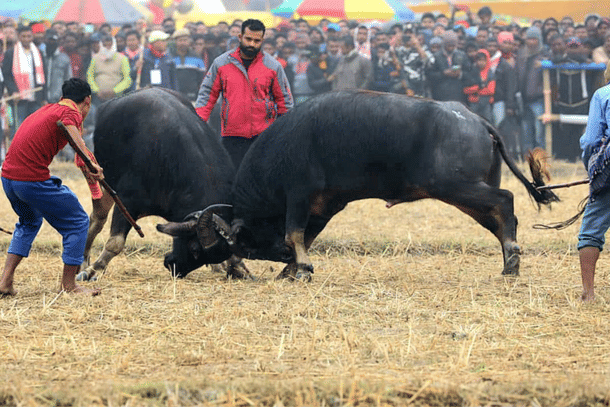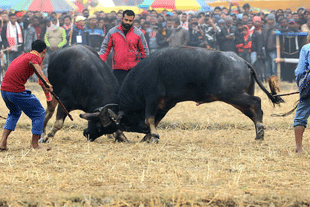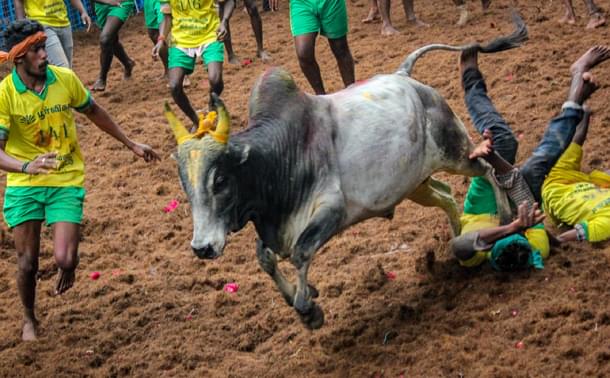Culture
Fight For Tradition: Can Assam Protect Buffalo And Bulbul Fights Without Compromising Animal Welfare?
Adithi Gurkar and Nabaarun Barooah
Jan 03, 2025, 10:30 AM | Updated Feb 11, 2025, 04:29 PM IST
Save & read from anywhere!
Bookmark stories for easy access on any device or the Swarajya app.


Buffalo fights, locally known as Moh Juj, are deeply ingrained in Assam's cultural fabric, especially during the Magh Bihu festival.
The practice was first institutionalised nearly 200 years ago by the thirtieth Ahom king, Swargadeo Rudra Singha, in Rangghar, the Ahom capital of Sibsagar. It was later introduced to Nagaon and Morigaon by the Tiwa chief Gobha Raja and held in Ahatguri.
The traditional sport is tied to the region’s rural and agricultural traditions, where male domestic buffaloes play a crucial role in ploughing fields. These fights were historically a way to showcase the strength, stamina, and skill of these animals, reflecting the training imparted by their owners.
Nevertheless, the sport is now at a cross-roads due to intervention of the Gauhati High Court which has re-introduced a ban on both buffalo and bulbul fights that are organised this season. The issue centres around balancing the preservation of cultural traditions with the ethical treatment of animals.
While the importance of animal welfare is widely acknowledged, the ban raises questions about the erosion of cultural identity. Concerns also linger about potential unintended consequences.
To better understand the legal and ethical considerations, we must first understand the historical significance of these practices within Assamese culture. Could there be ways to continue these traditions while doing our best for animal welfare as well?
Why buffaloes?
The buffaloes involved in these fights are domesticated animals, primarily from the Morigaon and Nagaon districts. Though initially informal, the practice became a highlight of the Bihu festival, drawing local communities, such as the Tiwas and Ahoms, together for a shared celebration.
The buffalo fights in Ahatguri now attract over 20,000 spectators annually, who gather to witness the spectacle, contributing significantly to the region's tourism and local business.
Despite concerns, locals argue that fatalities among the buffaloes are rare, and proper precautions are in place to ensure the safety of both the animals and participants.
In recent years, buffalo fights have seen a revival, particularly during the Magh Bihu festival, where they remain an important cultural event.
The other main event is Bulbul fighting. This spart in Assam traces its origins to the seventeenth century, linked to the Hayagriv Madhav Temple in Hajo. The practice, credited to the Ahom king Pramatta Singha, has since become a key feature of the Magh Bihu festival, particularly at the Maghi Mela.
Some argue the tradition is even older, rooted in rituals dedicated to Hayagriva, the horse-headed avatar of Vishnu, with the Ahoms adopting it in the seventeenth century.
The event, still organised under the patronage of the Doloi (head priest) of the temple, draws large crowds and remains a central part of Assamese cultural and religious life.
Local families in areas like Bharali Tola and Sonari Tola catch and tame wild red-vented bulbuls for the fight. These birds are cared for, fed a special diet, and trained for the fight.
The training involves building trust between the bird and its owner, who feeds them bananas, milk, and sweets. The birds are not subjected to cruelty; instead, they are treated with care and respect. Handlers claim that the birds even play with them.
On the eve of the fight, the birds are sometimes given safe, mild intoxicants under expert supervision to energise them.
On the day of the fight, the two groups of participants gather at the Hayagriv Madhav Temple. After a puja, the birds compete for a banana placed on a table, with the fighting behaviour prompted by their desire for the food.
The event is closely monitored, and the locals claim that there are no reports of bird fatalities.
The competition attracts thousands of spectators, and winners are awarded prizes. It is a highly anticipated cultural event, highlighting the community's bond with and reverence for the tradition. The practice is deeply rooted in Assamese culture and offers significant economic benefits through tourism.
Despite concerns over animal welfare, proponents of Bulbul fighting argue that the birds are well cared for and not harmed in any way. The event has been regulated by the Government of Assam, which has approved it under certain guidelines, ensuring the welfare of the birds and the safety of participants.
The Jallikattu precedent
Trouble for both buffalo and bulbul fighting first began with the Jallikattu judgement. In 2014, following the Animal Welfare Board of India vs A. Nagaraja & Ors case (commonly known as the Jallikattu case), the Supreme Court of India banned traditional bull taming in Tamil Nadu and prohibited bullock cart races across the country.
In response, the Government of Assam issued an order on 13 January 2015, prohibiting bulbul fights during the Bihu festival.
However, the Sri Sri Hayagriv Madhav Temple Committee of Hajo challenged this ban in the Gauhati High Court through a writ petition.
On 22 December 2023, the High Court ruled that the Supreme Court's decision, which was based on injuries inflicted on racing bulls, could not be applied to ban ritualistic bird fights.
The court kept the ban order in abeyance until further notice.
Thereafter, the Assam government issued standard operating procedures (SOPs) for bulbul bird fights, allowing them to take place only during the Magh Bihu festival at the Sri Sri Hayagriva Madhava Temple in Hajo, with necessary precautions to ensure the welfare of the birds.
The SOPs require organisers to ensure that the birds are released in "perfect condition" at the end of the event. Any violations of the SOPs would result in a ban on organising the event for the next five years.
Similarly, after the Supreme Court's ban on Jallikattu and associated bull-related events, authorities in Dharamtul of Morigaon district prevented the Oitigya Mandita Ahatguri Anchalik Moh-Juj and Bhogali Bihu Utsav Samiti from holding buffalo fights during the Bhogali Bihu Utsav.
The Samiti petitioned the Gauhati High Court, which, on 10 October 2023, directed the Assam government to address concerns about the welfare of the animals involved in the event and to make a conscious decision on the matter.
On 8 December 2023, the Assam Cabinet decided to allow buffalo and other traditional bird fights to take place in areas where they had historically been held. The Cabinet also directed the Home and political departments to draft a comprehensive SOP to regulate these events and ensure that cruelty to animals won't be tolerated.
The SOPs aim to reduce animal suffering by prohibiting deliberate cruelty, including the use of intoxicants or performance-enhancing drugs, sharp instruments to provoke aggression, and any human-inflicted injuries to the buffaloes.
These measures were introduced after nearly a nine-year hiatus, and in 2024, the Magh Bihu festival saw the revival of both buffalo and bulbul fights. Assam Chief Minister Himanta Biswa Sarma hailed it as a significant step in "preserving Assam’s timeless Bihu traditions."
However, People for the Ethical Treatment of Animals (PETA) India challenged these SOPs in the Gauhati High Court, requesting the full prohibition of these activities.
In two connected petitions, PETA cited their investigation into events in Ahatguri and Hajo, which revealed instances of cruelty, such as buffaloes being subjected to pain and injury, and bulbuls being captured and "provoked to fight over food, contrary to their natural instincts."
After reviewing the petitions and the investigative reports provided by PETA, the Gauhati High Court ruled that both buffalo and bulbul fights violated the Prevention of Cruelty to Animals Act, 1960, and the Wildlife Protection Act of 1972.
Why the Ban is Unsustainable
Following the Supreme Court's verdict on Jallikattu, the Centre issued a notification allowing bulls to continue being trained for events such as Jallikattu and bullock cart races in states where these practices were considered part of the cultural heritage, including Maharashtra, Karnataka, Punjab, Haryana, Kerala, and Gujarat.
In response, Tamil Nadu, Karnataka, and Kerala amended the Prevention of Cruelty to Animals Act, 1960, to accommodate these events.

When the Animal Welfare Board challenged these amendments in the Supreme Court, arguing that they were cosmetic changes intended to override the previous judicial verdict, the Supreme Court made the following observation:
"The expressions Jallikattu, Kambala and Bull Cart Race as introduced by the Amendment Acts of the three States have undergone substantial change in the manner they were used to be practised or performed and the factual conditions that prevailed at the time the A Nagaraja judgment was delivered cannot be equated with the present situation."
The court recognised that the pain-inflicting practices of these events had been significantly reduced due to statutory changes.
In light of this observation, the Assam government could adopt a similar approach by amending the 1960 Act to allow buffalo races in the state.
This was referenced in the obiter dicta of the recent judgement enforcing the ban. Justice Baruah observed that the Supreme Court, in 2023, allowed bull-taming sports in Tamil Nadu, Karnataka, and Maharashtra because those states had made amendments to the 1960 Act, which received presidential assent.
The Gauhati High Court's differential treatment of Assam's buffaloes stemmed from the fact that, unlike these states, Assam did not amend the 1960 Act but attempted to bypass both the Prevention of Cruelty to Animals Act, 1960, and the Wildlife Protection Act, 1972, as well as the 2014 Supreme Court judgement, by issuing an executive order. The court found this approach impermissible.
The Additional Senior Government Advocate for Assam argued that the Assam government should be allowed to take similar actions as Tamil Nadu, Maharashtra, and Karnataka. However, the court was non-committal and clarified that such actions fell within the domain of the state legislature.
Moreover, the Supreme Court, while upholding the amendments made by state governments, emphasised that its jurisdiction was not to guarantee absolute protection from any form of pain but to prevent unnecessary suffering.
India is not the first country to frame laws accommodating cultural practices related to animals. In 2013, Spain's Congressional commission declared bullfighting part of its cultural heritage, worthy of protection.
As a matter of fact, the sport benefits from the largess of the European Union’s common agricultural policy (CAP), which is supported by funds totalling 386 billion euros. According to the Professional Non-Profit Fighting Bull Livestock Breeders Association, without these subsidies, the bull breeding sector would face a shortfall of roughly 200 million euros in a given CAP period of five years.
This example highlights the potential consequences of arbitrary bans, which could have far-reaching consequences, including the extinction of native Indian animal breeds and depriving farmers of additional sources of income.
Regarding bulbuls, the Wildlife Protection Act, 1972, affords special protection to the red-vented bulbul (Pycnonotus cafer), listed under Schedule II, Part B, as a species requiring high protection.
This means the bird cannot be hunted unless it poses a threat to human life or is suffering from an incurable disease, entrenched in Section 9 of the Act. Section 2 of the Act defines hunting as capturing, coursing, snaring, trapping, driving, or baiting any wild or captive animal and every attempt to do so. It includes injuries.
It was on this basis that the High Court ruled against the state of Assam, declaring that permitting bulbul fights was unlawful, as even capturing the bird is prohibited under Section 51 of the Act.
As the forty-second amendment transferred the subjects of forest, wildlife, and bird protection from the State List to the Concurrent List, state governments cannot pass laws conflicting with central legislation.
Therefore, it would be prudent for the Assam government to pass a resolution urging the central government to either remove the red-vented bulbul from the second schedule or create a specific exception for cultural practices like bulbul fights in Assam.
It is important to note that the red-vented bulbul is classified as of Least Concern (LC) on the IUCN Red List (International Union for Conservation of Nature), meaning the species is not threatened, and its population is increasing.
It is also not listed in the appendices of the Convention on International Trade in Endangered Species (CITES) and is often regarded as an invasive alien species.
Dangers of Standardising Morality
The ban on buffalo and bulbul fights in Assam, enforced by the Gauhati High Court, poses a significant challenge to the preservation of integral cultural traditions in the region.
These events are not just recreational activities; they are expressions of the deep cultural, agricultural, and religious life of the Assamese people.
While safety concerns are valid, it is crucial to acknowledge the historical importance of these practices and their role in the identity of the local communities.
Buffalo and bulbul fights have existed for centuries, reflecting the relationship between the people of Assam and their environment. They are part of an ancient tradition that has evolved alongside the region's agricultural and religious practices.
To sever such a deep connection by banning these practices outright would be to erase a significant part of the region’s cultural heritage.
It is also important to note that the scale of these events is relatively small, and the number of animals involved is limited. The buffalo fights, primarily confined to areas like Morigaon and Nagaon, involve a few domesticated buffaloes raised for agricultural purposes. These buffaloes are trained with care by their owners, who view them as vital contributors to the region’s agrarian economy.
Similarly, bulbul fights involve only a handful of carefully nurtured birds, and the events themselves are confined to specific locales like the Hayagriv Madhav Temple. These practices are not mass-scale occurrences that exploit animals on a widespread basis; rather, they are localised, community-based events with a long history.
Banning them across the board fails to acknowledge the nuance of the situation and would penalise traditions that have evolved responsibly within their local context.
The economic impact of these events is also significant. Buffalo and bulbul fights attract thousands of spectators, contributing to the local economy. Farmers, artisans, and businesses benefit from the influx of visitors, creating employment and opportunities. The tourism driven by these events fosters cultural exchange and awareness, strengthening the sense of community in rural Assam.
Banning these traditions would harm the local economy and diminish the sense of community that these events foster. The continuity of these traditions allows economic development rooted in culture, agriculture, and tourism. They cannot be easily replaced by other activities.
Instead of a blanket ban, a more effective solution would be to establish clear regulations ensuring the humane treatment of animals. The Assam government can create a structured SOP to ensure the welfare of the animals involved, including mandatory veterinary checks, limitations on harmful substances, and strict monitoring of the events to ensure they are conducted safely. This approach would allow the traditions to continue in a responsible and ethical manner, while ensuring animal welfare.
It is important to recognise that imposing modern moral standards on rural traditions without understanding their cultural significance is counterproductive. Rather than erasing these practices, it is better to reform them in a way that respects both tradition and animal rights.
India is a country of immense cultural, religious, and regional diversity, and this diversity is reflected in the variety of practices and rituals followed by different communities.
The Hindu faith, for instance, encompasses a wide range of beliefs, deities, and rituals that vary from region to region. The practices associated with local deities like Hayagriva or Kamakhya, which involve buffalo sacrifices and bulbul fights, are as integral to the faith as rituals honouring more widely known gods like Vishnu or Krishna.
Imposing uniform ethical standards on such practices ignores the richness and diversity of religious expression in India. The forced standardisation of rituals would not only diminish the cultural richness of the Hindu faith but also lead to an unwarranted secularisation of religious practices, disregarding the local and regional dimensions of belief.
This could result in the forced ‘Abrahamisation’ of the Hindu faith, erasing its diverse expressions.
Just as the worship of regional deities is vital to Assam’s religious life, so are the rituals associated with those deities, including traditional animal fights. A ban would be a misguided attempt to secularise what is, for many, an important aspect of their faith and identity.
Adithi Gurkar is a staff writer at Swarajya. She is a lawyer with an interest in the intersection of law, politics, and public policy. Nabaarun Barooah is an author and commentator.




